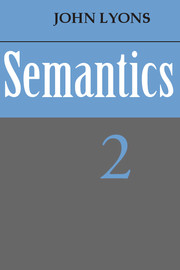Book contents
- Frontmatter
- Contents
- Figures
- Typographical conventions
- Preface
- 10 Semantics and grammar I
- 11 Semantics and grammar II
- 12 Semantics and grammar III
- 13 The Lexicon
- 14 Context, style and culture
- 15 Deixis, space and time
- 16 Mood and illocutionary force
- 17 Modality
- Bibliography
- Index of subjects
- Index of personal names
11 - Semantics and grammar II
Published online by Cambridge University Press: 05 June 2012
- Frontmatter
- Contents
- Figures
- Typographical conventions
- Preface
- 10 Semantics and grammar I
- 11 Semantics and grammar II
- 12 Semantics and grammar III
- 13 The Lexicon
- 14 Context, style and culture
- 15 Deixis, space and time
- 16 Mood and illocutionary force
- 17 Modality
- Bibliography
- Index of subjects
- Index of personal names
Summary
Parts-of-speech, form-classes and expression-classes
In this and the immediately following sections, we shall be concerned primarily with two questions: (i) Do all languages have the same parts-of-speech (i.e. nouns, verbs, adjectives, etc.)? (ii) To what degree are semantic considerations relevant to the definition of such terms as ‘noun’, ‘verb’ or ‘adjective’? These two questions, as we shall see, are intrinsically connected. Curiously enough, they are only rarely discussed nowadays. And yet they are crucial in any treatment of the relation between grammar and semantics.
Although most of the published grammars and dictionaries of particular languages make use of the traditional terms ‘noun’, ‘verb’, ‘adjective’, etc., the standard definitions of such terms have long been criticized by linguists as being unsatisfactory in several respects. It has been argued that they are circular; that they depend upon a mixture of morphological, syntactic and semantic criteria, which do not necessarily coincide in particular instances; and that they are inapplicable to languages whose grammatical structure differs significantly from that of the classical Indo-European languages. The approach which, in outline only, we present here concedes that there is considerable force in these criticisms, but also gives due recognition to those aspects of the traditional theory which are relevant to the central concerns of this book and, with certain qualifications and clarifications, are of enduring validity.
- Type
- Chapter
- Information
- Semantics , pp. 423 - 466Publisher: Cambridge University PressPrint publication year: 1977



